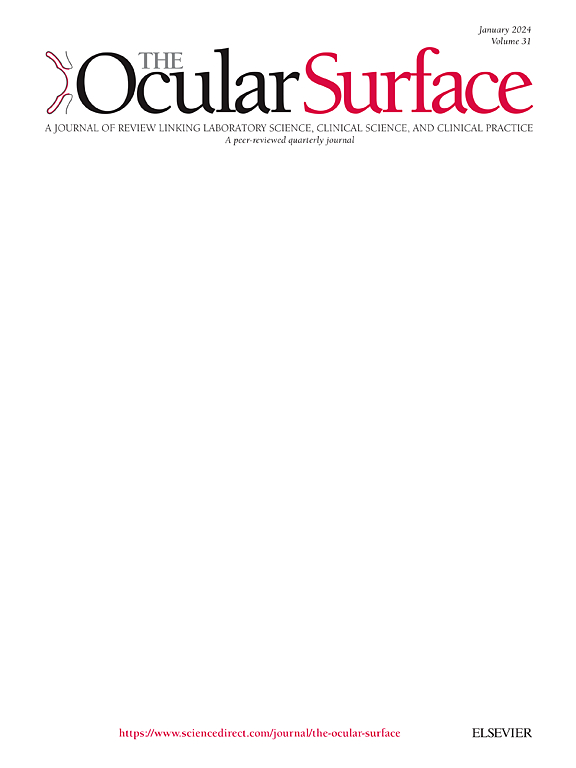眼过敏局部治疗的疗效排名:当前证据的网络荟萃分析
IF 5.6
1区 医学
Q1 OPHTHALMOLOGY
引用次数: 0
摘要
目的通过系统综述和网络荟萃分析,对不同类型眼部过敏的局部治疗效果进行评价和排序。方法系统检索2000年1月至2024年12月PubMed、Cochrane CENTRAL、谷歌Scholar和Scopus数据库中的电子数据库。研究选择;随机对照试验评估眼部过敏的局部治疗,包括抗组胺药、皮质类固醇、免疫调节剂和联合治疗。数据提取与综合;数据按照PRISMA指南独立提取和分析。使用网络荟萃分析评估直接和间接比较,SUCRA排名评估相对疗效。主要成果和措施;减轻眼部瘙痒、红肿和炎症。普洛斯彼罗注册号:CRD42025634572。结果0.1%索洛他定对季节性和常年性变应性结膜炎的疗效最高(SUCRA分别为0.88和0.85),0.1%他克莫司对春季性和特应性角膜结膜炎的疗效最高(SUCRA分别为0.92和0.89)。总体治疗效果显著(OR = 6.95, 95% CI: 6.24-7.75),异质性中等(I2 = 50.8%)。亚组分析显示,不同类型变应性结膜炎的疗效一致,季节性变应性结膜炎的累积排名概率最高(89.0%)。结论:该网络荟萃分析为眼部过敏的特异性治疗方法提供了强有力的证据。较新的抗组胺药,特别是奥洛帕他定,对轻中度疾病最有效,而免疫调节剂,特别是他克莫司,在严重病例中表现出更好的疗效。这些发现为不同类型过敏性结膜炎的临床决策提供了明确的循证分级。本文章由计算机程序翻译,如有差异,请以英文原文为准。
Ranking the efficacy of topical treatments for ocular allergy: A network meta-analysis of current evidence
Purpose
To evaluate and rank the comparative effectiveness of topical treatments for different types of ocular allergies through a systematic review and network meta-analysis.
Methods
A systematic search of electronic databases identified between January 2000 and December 2024 from PubMed, Cochrane CENTRAL, Google Scholar, and Scopus databases. Study Selection; randomized controlled trials assessing topical treatments for ocular allergy, including antihistamines, corticosteroids, immunomodulators, and combination therapies. Data Extraction and Synthesis; data were independently extracted and analyzed following PRISMA guidelines. Direct and indirect comparisons were evaluated using network meta-analysis, and SUCRA rankings assessed relative efficacy. Main Outcomes and Measures; reduction in ocular itching, redness, and inflammation. PROSPERO Registration number: CRD42025634572.
Results
Olopatadine 0.1 % demonstrated highest efficacy in seasonal and perennial allergic conjunctivitis (SUCRA 0.88 and 0.85, respectively), while Tacrolimus 0.1 % showed superior effectiveness in vernal and atopic keratoconjunctivitis (SUCRA 0.92 and 0.89, respectively). Overall treatment effect was significant (OR = 6.95, 95 % CI: 6.24–7.75) with moderate heterogeneity (I2 = 50.8 %). Subgroup analysis revealed consistent efficacy across different types of allergic conjunctivitis, with seasonal allergic conjunctivitis showing the highest cumulative ranking probability (89.0 %).
Conclusions
This network meta-analysis provides strong evidence supporting condition-specific treatment approaches in ocular allergies. Newer antihistamines, particularly Olopatadine, are most effective for mild-moderate conditions, while immunomodulators, especially Tacrolimus, show superior efficacy in severe cases. These findings provide clear evidence-based hierarchies for clinical decision-making in the management of different types of allergic conjunctivitis.
求助全文
通过发布文献求助,成功后即可免费获取论文全文。
去求助
来源期刊

Ocular Surface
医学-眼科学
CiteScore
11.60
自引率
14.10%
发文量
97
审稿时长
39 days
期刊介绍:
The Ocular Surface, a quarterly, a peer-reviewed journal, is an authoritative resource that integrates and interprets major findings in diverse fields related to the ocular surface, including ophthalmology, optometry, genetics, molecular biology, pharmacology, immunology, infectious disease, and epidemiology. Its critical review articles cover the most current knowledge on medical and surgical management of ocular surface pathology, new understandings of ocular surface physiology, the meaning of recent discoveries on how the ocular surface responds to injury and disease, and updates on drug and device development. The journal also publishes select original research reports and articles describing cutting-edge techniques and technology in the field.
Benefits to authors
We also provide many author benefits, such as free PDFs, a liberal copyright policy, special discounts on Elsevier publications and much more. Please click here for more information on our author services.
Please see our Guide for Authors for information on article submission. If you require any further information or help, please visit our Support Center
 求助内容:
求助内容: 应助结果提醒方式:
应助结果提醒方式:


